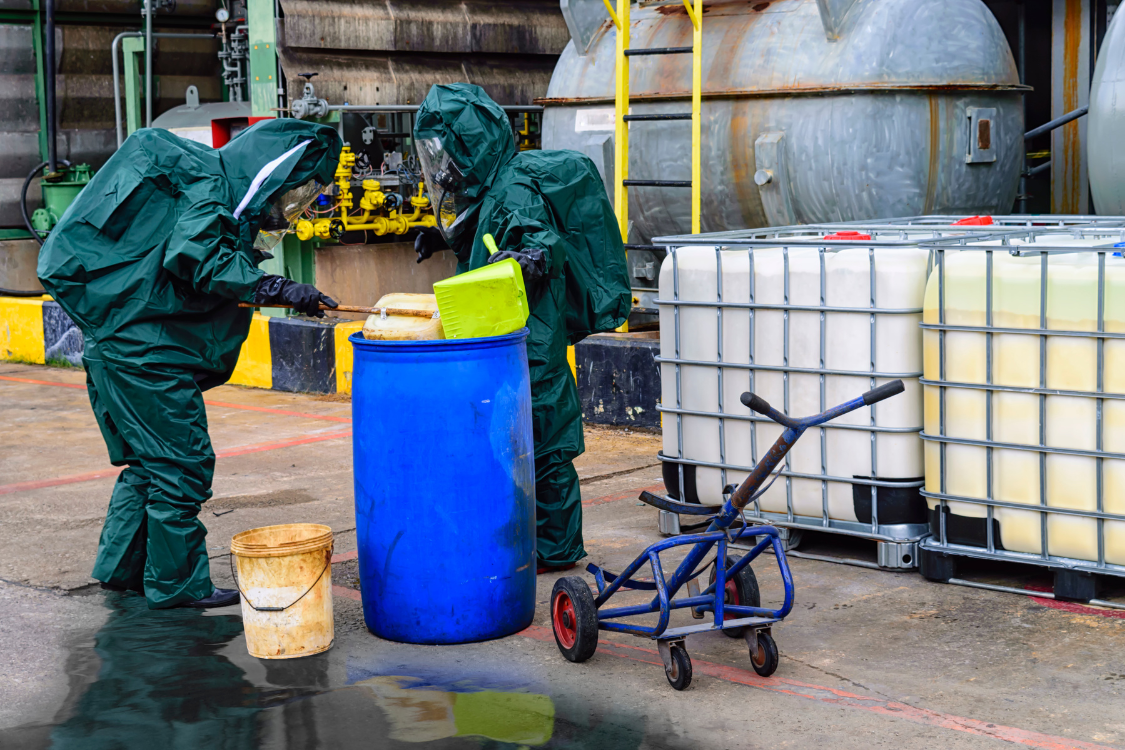The Difference Between A Chemical Spill And Chemical Release

CONTENTS
- Defining a chemical spill and chemical release
- The impact of chemical spills
- Health hazards associated with chemical releases
- Mitigation strategies for chemical spills
- Response protocols for chemical releases
- Frequently asked questions
- Get in touch
In environmental safety and hazard management, distinguishing between a chemical spill and a chemical release is paramount. This distinction informs the immediate response required and promotes long-term remediation strategies.
At ICE Cleaning, our chemical spill clean-up services ensure your business is safe to work in again once we leave. Our team can effectively contain and clean a spill, decontaminating the area so business can resume with minimal disruption.
Read on to learn the difference between a chemical spill and a chemical release.
Defining a chemical spill and chemical release
The difference between a chemical spill and a chemical release is critical for effective hazard management within residential, commercial, and industrial settings.
Understanding these terms allows homeowners and professionals to implement appropriate response strategies, mitigating potential environmental and safety risks.
A chemical spill is a release of hazardous chemicals from a container. It can happen during storage, handling, transportation, or use of chemicals, and can cause environmental contamination, safety hazards, and health risks.
In contrast, a chemical release is the accidental release of a hazardous chemical into the environment. This can happen in various settings and involves gases, liquids, or solids being released into the air, water, soil, or other media.
The impact of chemical spills
The consequences of chemical spills extend beyond the immediate disruption they cause, contaminating ecosystems and potentially leading to long-term environmental harm.
Following a chemical spill, the main priority is addressing the effects on local wildlife and habitats. Aquatic environments are particularly vulnerable, with spills often leading to significant reductions in water quality.
This can result in oxygen depletion, severely affecting fish populations and disrupting aquatic food chains. Terrestrial ecosystems also suffer as chemicals seep into the soil, affecting plant life and soil organisms essential for nutrient cycling.
Chemical spills can lead to persistent environmental issues that require years or even decades to fix. Contaminants may accumulate in sediments, posing ongoing risks to local wildlife.
The infiltration of hazardous substances into water sources also increases human exposure risks through consumption or direct contact with contaminated resources.
Finally, the cost of cleaning up after a spill with potential losses in tourism, fishing industries, and agriculture highlights the economic dimension of such environmental disasters.
Health hazards associated with chemical releases
The accidental release of chemicals into the environment poses significant health risks, requiring immediate and effective response strategies. Understanding the effects is paramount for protecting human health.
Acute health effects
Chemical releases can lead to immediate health issues, varying in severity based on exposure levels and the nature of the chemicals involved. Common acute effects include:
- Skin irritation or burns from direct contact
- Eyes watering or vision impairment due to exposure
- Inhalation leading to respiratory difficulties or lung damage
- Nausea, vomiting, or dizziness as a result of ingestion or inhalation
Chronic health effects
Prolonged exposure to certain chemicals can have long-term impacts on human health. These chronic conditions may develop over time even after minimal exposure levels:
- Cancerous growths attributed to toxic substances
- Liver and kidney diseases from systemic toxicants
- Neurological disorders, including cognitive decline
- Breathing problems like asthma induced by persistent irritant exposure
Mitigation strategies for chemical spills
Effective management and prevention of chemical spills are paramount in protecting environmental integrity and public safety. To prevent chemical spills, companies must implement rigorous preventative strategies. These include:
- Regular inspections of storage facilities, pipelines, and containers to detect potential weaknesses or failures
- Secondary containment systems to capture leaks or overflows before they can impact surrounding areas
- Conduct a thorough chemical risk assessment in the workplace, inspecting storage, handling, and transportation processes
- Develop comprehensive spill response plans outlining procedures for containing, controlling, and cleaning spills
- Train employees on spill response protocols and provide access to spill response equipment
- Implement a routine inspection and maintenance program to identify and address potential sources of chemical spills
The evolution of technology is also pivotal in enhancing spill prevention capabilities. Advanced materials such as polymers that swell upon contact with chemicals are utilised to create self-sealing barriers around storage vessels.
Similarly, remote sensing technologies enable real-time monitoring of hazardous material levels within tanks, alerting staff when problems occur and encouraging immediate intervention. An example of these include:
- Smart barriers: Sensors that trigger alarms upon detecting leaks
- Absorbent materials: New absorbents like pillows, socks, and pads capable of neutralising various chemicals efficiently
- Drones for surveillance: Deploying drones equipped with cameras and sensors to monitor large industrial areas prone to spill risks from above.
Response protocols for chemical releases
In the event of a chemical release, immediate and informed action is paramount to mitigate risks to health, property, and the environment. The Health and Safety Executive (HSE) has established comprehensive procedures designed to manage such incidents effectively:
- Assess: Determine the type and quantity of chemicals involved, the extent of the spill, and any immediate hazards to personnel, the environment, or surrounding areas.
- Alert: Immediately notify all personnel in the area and initiate evacuation procedures if necessary.
- Protect: Put on appropriate PPE to protect yourself from chemical exposure, including gloves, goggles, face shields, and respiratory protection.
- Contain: Use barriers, absorbent materials, or other containment devices to confine the spill and prevent it from reaching waterways, drains, or sensitive areas.
- Evaluate: Assess the risks associated with the spilt chemical, including potential fire, explosion, or health hazards.
- Contact: Get in touch with a professional cleaning company that can quickly contain, clean, and decontaminate the area.
Frequently asked questions
What is the difference between a chemical release and a spill?
A chemical release means gases or liquids escape into the environment, often from machinery. A spill involves accidental liquid leakage.
What is the protocol for a chemical spill?
Evacuate if needed, and contain the spill to prevent spreading before calling professional cleaners.
What are the 5 steps of a chemical spill?
Identify hazards; protect yourself; confine the spill; clean it safely; report and document everything that happened.
What are the 3 Cs of a chemical spill?
The 3 C's stand for Control, Contain, and Clean. They guide quick and safe responses to spills.
Get in touch
For chemical spill cleaning services, our emergency team at ICE Cleaning can help. No matter where you are in the UK, our emergency team can be on-site the same day as your initial call, ensuring safety the entire time.
To learn more about our chemical cleaning services, get in touch with our team today at 0208 066 0360 or enquiries@icecleaning.co.uk. We are available 24/7, 365 days a year, so no matter when or where accidents occur, we can help.

Speak with me today,
I’m here to help
By asking you a few questions either via phone or email I can immediately provide a realistic estimation of the cost.

Why choose us?
- Cater to a wide variety of cleaning situations
- Nationwide coverage, available 24/7
- Cater to commercial and domestic clients
- Free survey provided prior to quotation
- Emergency response team
- Offer a bespoke service designed to suit all your needs
- All technicians hold professional health and safety qualifications, including BICSc, IOSH, Dewpoint Professional & Safe Contractor
We’re fully accredited
We place best practise, professional expertise and health and safety at the core of our business. We’re fully compliant with all legal obligations. You can view a list of our accreditations below, or visit our Health & Safety page for more information.











-RGB-small.1707319151.jpg)




















